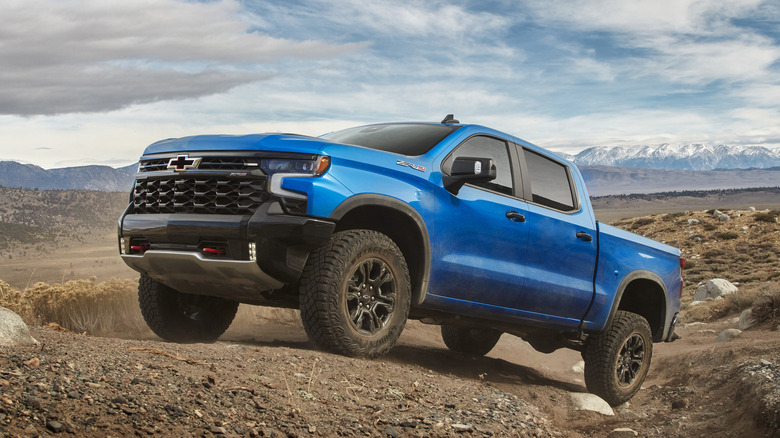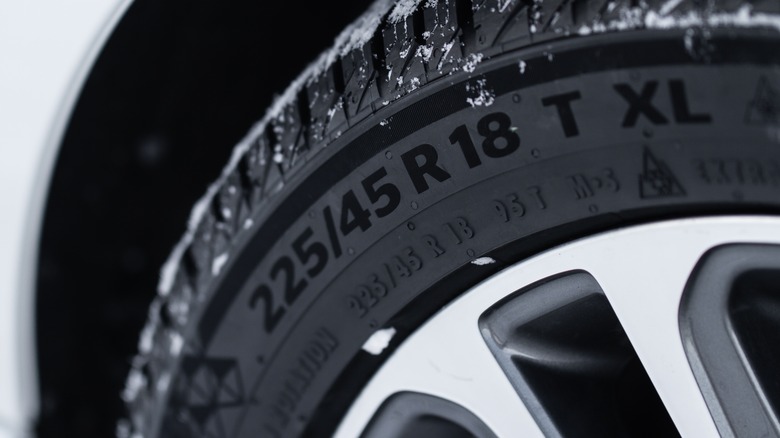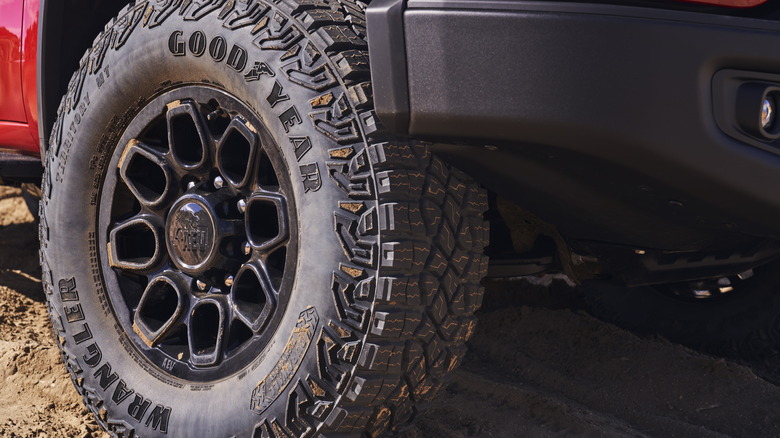How To Choose The Best Tires For Your Chevy Silverado
Picking the right tires for any vehicle is a pretty important task. Tires can be an expensive purchase, so you want to make sure they last a while and are a good value. Of course, you want to make sure you pick the right size, too, and that other customers were satisfied with their purchase. Maybe you want a set of tires that's low on road-noise, or maybe you want to get the most life out of your tire possible — going years between switching out sets — but there are a number of priorities worth considering.
With a pickup truck like the Chevy Silverado, however, there are likely a few extra concerns when you're picking tires. If you tow and haul on a regular basis, you'll need tires optimized for those tasks and capable of handling the proper amount of weight. Enjoy off-roading? There are great all-terrain tires and mud-terrain tires to choose from that will get you way out into the wilderness if that's where you want to go. If you live in an area that regularly sees lots of snow or ice in the winter, that's likely a top consideration for your tires as well. So how do you sort through these considerations when it comes to picking a tire for your Silverado? Let's dig in.
Which tire category is right?
Tires are broken down into a few main categories. Track tires, high-performance tires, and competition tires aren't likely to be used on trucks like the Silverado, so we scrap those from the start. When shopping for new Silverado tires, you're likely to see touring tires, all-terrain tires and winter/snow tires on your list of potential matches. Touring tires come in a variety of categories that vary in stated priority like traction, ride quality, and tread life. All-terrain tires are typically optimized for traction in non-paved situations like off-roading, but they sacrifice a bit of comfort, and they're typically much louder than your standard road-oriented tires. The Silverado's off-road oriented ZR2 trim, for example, comes with knobby all-terrain tires that perform well in the dirt.
Finally, winter tires are specialized at tackling tough weather conditions like snow and ice, but they shouldn't be used in summer. Winter tires are typically reserved for only winter road conditions, and in many cases they're unsuitable to regular road conditions. Be sure to pick a category of tire that makes the most sense for how you use your Silverado.
Getting the right size
Tire sizes are printed on the side of your tire, and picking the right size is a big factor in tire performance (it's also pretty important if you want your new tires to fit at all). Here's an example of one of the tire sizes that comes standard on the 2025 Silverado: P255/70R17. The "P" stands for P-Metric or passenger tire –typically a designation assigned to vehicles that are a bit lighter. Other tire specifications on the Silverado use "LT" tires, which stands for Light Truck (or Light Truck-metric). This is common on larger vehicles, as are "XL" tires which are reinforced to carry more weight.
Next is tire section width. With the aforementioned P255/70R17, the width is 255 millimeters. The "/70" refers to the tire's profile aspect ratio (tire height) expressed as a percentage. So, the sidewall here is 70% of the width. Crunch the numbers and 70% of 255 comes out to 178.5 millimeters. The sidewall height won't be listed on a tire, but getting the ratio right is important for a proper fit.
Finally, the letter and last two numbers — R17 in this case. The R here stands for Radial – the type of tire construction used. Other options you might include "D" for diagonal or bias-ply tires (not likely on modern trucks) and "RF" for run-flat (more common amongst sports cars that aren't packing a spare tire). Finally, the "17" refers to a 17-inch wheel that the tire is wrapped around.
Load index and speed rating
With trucks like the Silverado, a measurement called load index is important to pay attention to as well. The load index indicates how much weight a single tire can carry and that number is typically listed on the sidewall after a tire's size. In the Silverado's case, you might see something like this: P255/70R17 116T. We already went over the first portion, but that last set of numbers and letters is the load index and speed rating.
Most load indexes range between 70 and 126. The higher the number, the more weight a tire can carry. With a load index of 112, each tire would have a capacity of 2,469 pounds. Multiply by four and you've got a truck with tires that can handle a maximum weight of 9,876 pounds (assuming the weight is distributed evenly). Some LT truck tires also have multiple load indexes listed on the sidewall (for example: 105/100) which applies to dual-rear-wheel setups.
The letter T (after that 116) is the speed rating of the tire. A tire's speed rating is the maximum speed capable on a given tire. Most speed ratings are grouped by letters, ranging from L to Y. Extreme off-road tires will have a low speed rating — an L for example, which has a maximum speed of 75 mph. Many LT tires will have an R rating, which maxes out at 106 mph. The 112T tire in question here has a max speed of 118 mph.
Picking a non-OEM tire
Some owners will want to change their tires to something different than what came from the factory. Maybe you want better highway performance or more traction off-road. Maybe you want to change the size of your tire based on modification goals or aesthetics. Before you go changing tires, though, there are some important steps. First, you'll want to look at tire reviews. Sites like Tire Rack offer user reviews and often, you can find a review from someone who owns the same vehicle. With the Silverado being such a popular vehicle, finding tire reviews shouldn't be too tough.
Whether you're purchasing new OEM-replacement tires or second-hand tires, it's also very important to check the date code on the side of your tire. Older tires can be dangerous to drive on, even if they have an appropriate amount of tread remaining. Also, be aware that changing the size of your tire can affect your vehicle in a number of ways. The speed that displays on your speedometer will change if the tire's diameter is different, but fuel economy, handling characteristics, and road noise are all worth considering before swapping in a new set of tires. In some scenarios (like if you upgrade to a much bigger tire) you may want to recalibrate your speedometer to read the accurate speed.




